Giraffes are known for their towering height and unique appearance, but they also face significant threats from predators in the wild. While these gentle giants may seem too large to be threatened by predators, they are hunted by several carnivores in their natural habitat.
In this article, we will explore the topic of what predators eat giraffes, including the most common predators and the adaptations that giraffes have developed to avoid being eaten. We’ll also answer some common questions about giraffes and their interactions with predators.
Giraffe Predators
Giraffes are hunted by several predators in the wild, including lions, leopards, hyenas, wild dogs, and crocodiles. Lions are the most significant predators of giraffes, and they often hunt them in groups. Leopards are solitary hunters and prefer to hunt smaller prey, but they will occasionally attack giraffes. Hyenas and wild dogs are also known to hunt giraffes, but they are less successful than lions or leopards. Crocodiles, on the other hand, hunt giraffes when they come to the river to drink.
Lion
Lions are the main predators of giraffes. They use a variety of hunting techniques to capture giraffes, including stalking, ambush, and cooperative hunting. Lions prefer to hunt giraffes in groups, which increases their chances of success. They typically target young or weak giraffes, but they will also attack healthy adults if necessary.
Leopard
Leopards are solitary hunters and prefer to hunt smaller prey, such as antelopes and gazelles. However, they will occasionally attack giraffes, especially if other prey is scarce. Leopards use stealth and surprise to catch giraffes, leaping from trees or rocks onto their backs and biting their necks.
Hyenas
Hyenas are opportunistic hunters and will eat almost anything, including giraffes. They usually hunt giraffes at night when they are alone or separated from their group. Hyenas use their strong jaws and teeth to bring down giraffes and can consume an entire adult in a few hours.
Wild Dogs
Wild dogs are highly social and work together to hunt prey, including giraffes. They use their speed and agility to chase and exhaust their prey, eventually bringing it down with a bite to the neck or throat. Wild dogs typically target young or sick giraffes, but they will also attack adults if necessary.
Crocodiles
Crocodiles are ambush predators and will attack giraffes when they come to the river to drink. They use their powerful jaws and teeth to grab the giraffe’s neck and drag it underwater, drowning it. Crocodiles usually target young or weak giraffes.
Other Predators
While lions, leopards, hyenas, wild dogs, and crocodiles are the most common predators of giraffes, there are other predators that also pose a threat to these gentle giants. These predators include cheetahs, African wildcats, and African hunting dogs.
Adaptations of Giraffes to Avoid Predators
Despite being hunted by several predators, giraffes have developed several adaptations to avoid being eaten. Some of these adaptations include:
Long Legs
Giraffes have long, powerful legs that allow them to run at speeds of up to 35 miles per hour. This speed, combined with their size, makes them difficult for predators to catch.
Long Necks
Giraffes have long necks that allow them to spot predators from a distance. They also use their necks to fight off predators, swinging their heads like clubs to fend off attackers.
Running and Walking Abilities
Giraffes have a unique gait when running, called a “pacing gait,” which allows them to maintain their speed for long distances. They also have a “camel-walking gait,” which allows them to move slowly and smoothly, minimizing their movements and avoiding detection by predators.
Social Behavior
Giraffes are social animals and live in groups called towers. Living in a group allows them to watch each other’s backs, and they use their powerful kicks to fend off predators when attacked.
Spotting Predators
Giraffes have excellent eyesight and can see predators from a distance of up to one mile away. They also have keen hearing and can detect the sounds of predators from a distance.
FAQs
- Can giraffes fight off predators? Yes, giraffes use their powerful kicks and swinging necks to fend off predators when attacked.
- What is the main predator of giraffes? Lions are the most significant predators of giraffes.
- Do giraffes ever attack predators? Giraffes are generally peaceful animals and only attack predators when they or their young are threatened.
- Can giraffes swim? Yes, giraffes can swim, but they rarely do so unless they have to cross a river.
- How long do giraffes live in the wild? Giraffes can live up to 25 years in the wild.
Conclusion
In conclusion, giraffes are not immune to predation, and they are hunted by several predators in the wild. Lions are the most significant predators of giraffes, but leopards, hyenas, wild dogs, and crocodiles also pose a threat. However, giraffes have developed several adaptations to avoid being eaten, including their long legs, necks, and excellent running, walking, and social abilities.

